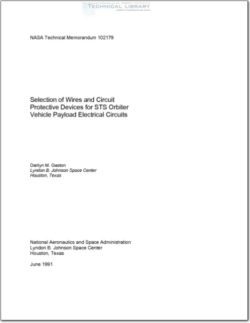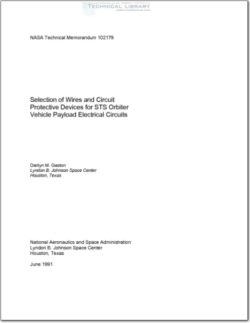NASA-TM-102179

- Version
- 233 Downloads
- 759.35 KB File Size
- 1 File Count
- May 18, 2016 Create Date
- May 18, 2016 Last Updated
Selection of Wires and Circuit Protective Devices for STS Orbiter Vehicle Payload Electrical Circuits

Electrical designers can find an array of guides to help them select wire size and
circuit protection. Until now, however, none would satisfy the unique design
requirements of an Orbiter payload in its particular environment using any one of the
many types of wire insulation currently available. This document is an attempt to
alleviate that situation somewhat by providing designers with methods for selecting wire
size and circuit protection that are appropriate to a particular installation. Remember,
however, that this acceptance pertains only to the thermal properties of the wire
insulation. Material properties of the insulation must still be evaluated and accepted by
the JSC Materials Branch.
Besides failing to be unique for a particular application, most guides fall short of
the designers’ expectations by providing tables and ratings without explanation, leaving
them to accept the information on faith alone. This document is no exception since test
data is not included. However, many of the more devious idiosyncrasies of spacecraft
wire and circuit protection are explained to give insight into some of the values provided
in the tables. Graphs and tables are included that may be used in selecting wire sizes
and circuit protection. Also, step-by-step instructions are provided to guide the user in
the application of the material. In order to provide additional clarity to the rather
complex procedure, two examples are worked out in appendix B to illustrate the
processes.
Although each aerospace vehicle is unique in its layout and requirements, this
guide is an attempt to present a systematic approach to the process of selecting proper
wire size and circuit protection for generic spacecraft. It applies to a broad range of
aerospace vehicles, but is primarily structured toward the STS with emphasis on
payload design and integration. Coverage, therefore, is limited to two ambient
pressures: 14.7 psi and 1 x 10'6 TORR; and, in vacuum conditions, tow temperature
levels: 70°F and 200°F.
| File | Action |
|---|---|
| NASA-TM102179 Selection of Wires and Circuit Protective Devices for STS Orbiter Vehicle Payload Electrical Circuits.pdf | Download |
Comment On This Post